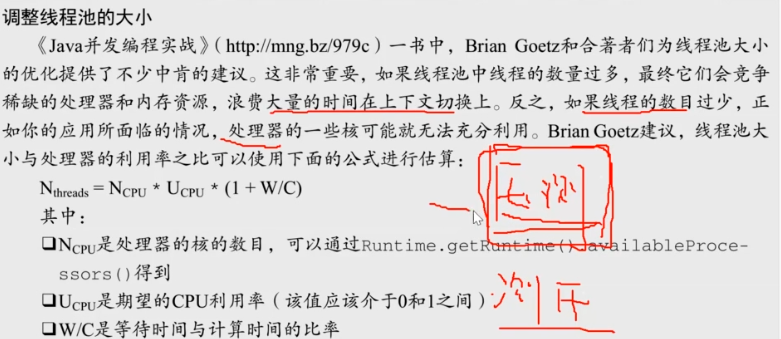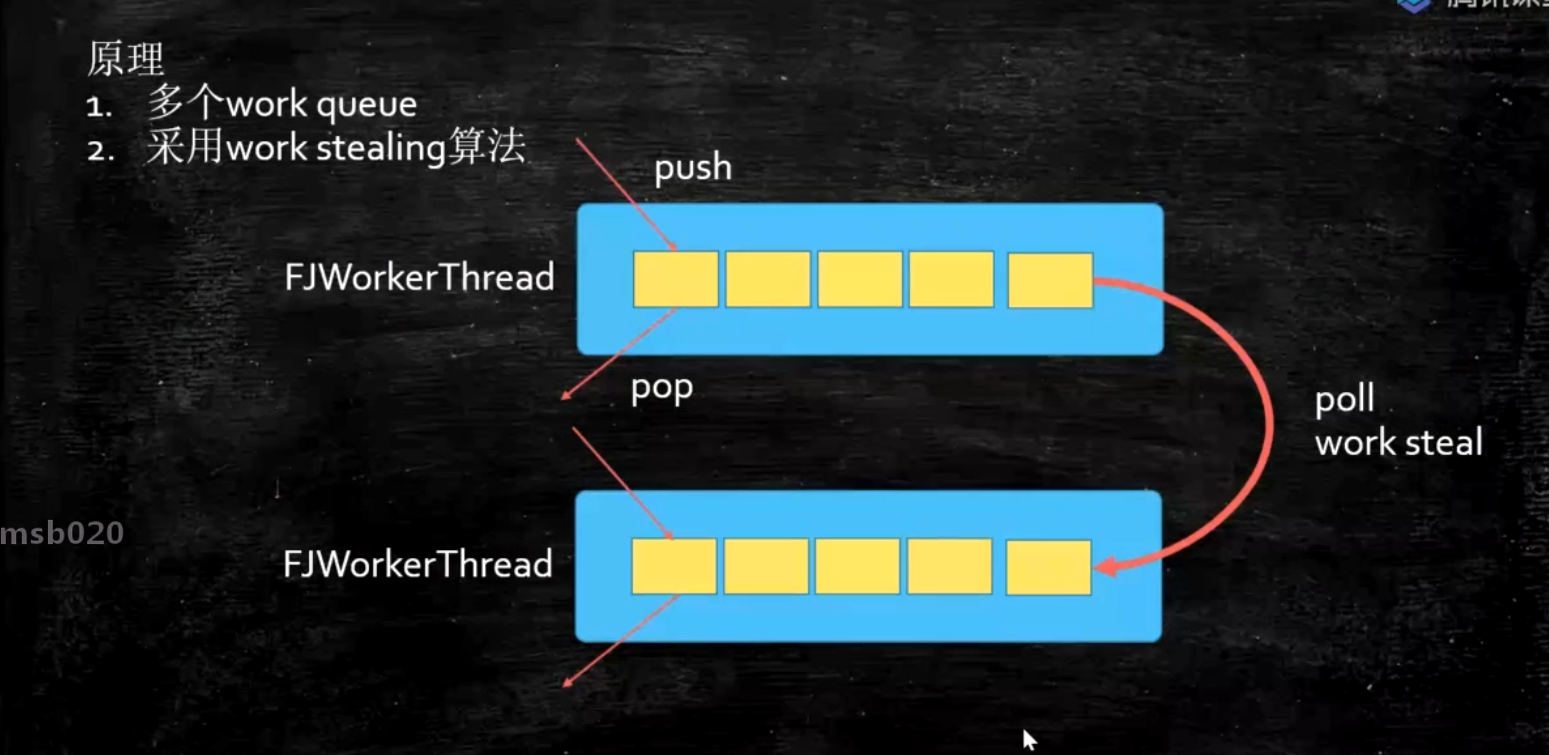多线程与高并发八-线程池及源码
几类线程池
ThreadPoolExecutor:我们通常所说的线程池。多个线程共享同一个任务队列。
-
SingleThreadPool
-
CachedThreadPool
-
FixedThreadPool
-
ScheduledPool
ForkJoinPoll:先将任务分解,最后再汇总。每个线程有自己的任务队列,适用CPU密集型
- WorkStealingPool
SingleThreadPool
SingleThreadPool 这个线程池里面只有一个线程。这样可以保证 我们扔进去的任务是被顺序执行的。
- SingleThreadPool 为什么要有单线程的线程池?
线程池有任务队列 可以提供生命周期管理
public static ExecutorService newSingleThreadExecutor() {
return new FinalizableDelegatedExecutorService
(new ThreadPoolExecutor(1, 1,
0L, TimeUnit.MILLISECONDS,
new LinkedBlockingQueue<Runnable>()));
}
CachedThreadPool
public static ExecutorService newCachedThreadPool() {
return new ThreadPoolExecutor(0, Integer.MAX_VALUE,
60L, TimeUnit.SECONDS,
new SynchronousQueue<Runnable>());
}
会根据任务数量创建相对应的线程数,不过CachedThreadPool的核心线程数默认为0,所以可想而知,这些创建出来的线程对应的都是最大线程数,这些线程会被缓存以试图能被重复使用,不过默认60秒没使用的话,就会被回收,所以这个类型的线程适合用于在短时间内大量短生命周期的异步任务时(many short-lived asynchronous task)。
阿里不推荐使用该线程池
public class T08_CachedPool {
public static void main(String[] args) throws InterruptedException {
ExecutorService service = Executors.newCachedThreadPool();
System.out.println(service);
for (int i = 0; i < 2; i++) {
service.execute(() -> {
try {
TimeUnit.MILLISECONDS.sleep(500);
} catch (InterruptedException e) {
e.printStackTrace();
}
System.out.println(Thread.currentThread().getName());
});
}
System.out.println(service);
TimeUnit.SECONDS.sleep(80);
System.out.println(service);
}
}
结果
java.util.concurrent.ThreadPoolExecutor@330bedb4[Running, pool size = 0, active threads = 0, queued tasks = 0, completed tasks = 0]
java.util.concurrent.ThreadPoolExecutor@330bedb4[Running, pool size = 2, active threads = 2, queued tasks = 0, completed tasks = 0]
pool-1-thread-2
pool-1-thread-1
java.util.concurrent.ThreadPoolExecutor@330bedb4[Running, pool size = 0, active threads = 0, queued tasks = 0, completed tasks = 2]
Process finished with exit code 0
FixedThreadPool
corePoolSize和 maximumPoolSize是一样的。并且他的keepAliveTime=0, 也就是当线程池中的线程数大于corePoolSize, 多余的空闲线程会被立即终止
FixedThreadPool使用了LinkedBlockingQueue, 也就是无界队列(队列最大可容纳Integer.MAX_VALUE), 因此会造成以下影响:
- 线程池线程数到达corePoolSize后,任务会被存放在LinkedBlockingQueue中
- 因为无界队列,运行中(未调用shutdown()或者shutdownNow()方法)的不会拒绝任务(队列无界,可以放入"无限"任务)
public static ExecutorService newFixedThreadPool(int nThreads) {
return new ThreadPoolExecutor(nThreads, nThreads,
0L, TimeUnit.MILLISECONDS,
new LinkedBlockingQueue<Runnable>());
}
Concurrent vs parallel
并发指任务提交,并行指任务执行;
并行是多个CPU同时处理,并发是多个任务同时过来;
并行是并发的子集
CachedThreadPool vs FixedThreadPool
| 特性 | FixedThreadPool | CachedThreadPool |
|---|---|---|
| 重用 | 能 重用就用,但不能随时建新的线程 | 缓存型池子,先查看池中有没有以前建立的线程,如果有,就 重用;如果没有,就建一个新的线程加入池中 |
| 池大小 | 可指定 nThreads,固定数量 | 可增长,最大值 Integer.MAX_VALUE |
| 队列大小 | 无限制 | 无限制 |
| 超时 | 无 IDLE | 默认 60 秒 IDLE |
| 使用场景 | 所以 FixedThreadPool 多数针对一些很稳定很固定的正规并发线程,多用于服务器 | 大量短生命周期的异步任务 |
| 结束 | 核心线程,不会自动销毁 | 注意,放入 CachedThreadPool 的线程不必担心其结束,超过 TIMEOUT 不活动,其会自动被终止。 |

ScheduledPool
public ScheduledThreadPoolExecutor(int corePoolSize) {
super(corePoolSize, Integer.MAX_VALUE, 0, NANOSECONDS,
new DelayedWorkQueue());
}
定时任务线程池,可以延迟执行任务,也可以周期性执行任务,也可以用quartz cron
ScheduledFuture scheduledFuture =
scheduledExecutorService.schedule(new Callable() {
public Object call() throws Exception {
System.out.println("Executed!");
return "Called!";
}
}, 5, TimeUnit.SECONDS);
System.out.println("result = " + scheduledFuture.get());
scheduledExecutorService.shutdown();
结果
Executed!
result = Called!
ForkJoinPool
将一个大任务拆分成多个小任务后,使用fork可以将小任务分发给其他线程同时处理,使用join可以将多个线程处理的结果进行汇总;这实际上就是分治思想的并行版本。可以有返回值或无返回值。Java8中的parallelStream API就是基于ForkJoinPool实现的
this(Math.min(MAX_CAP, Runtime.getRuntime().availableProcessors()),
defaultForkJoinWorkerThreadFactory, null, false);
}
package com.mashibing.juc.c_026_01_ThreadPool;
import java.io.IOException;
import java.util.Arrays;
import java.util.Random;
import java.util.concurrent.ForkJoinPool;
import java.util.concurrent.RecursiveAction;
import java.util.concurrent.RecursiveTask;
public class T12_ForkJoinPool {
static int[] nums = new int[1000000];
static final int MAX_NUM = 50000;
static Random r = new Random();
static {
for(int i=0; i<nums.length; i++) {
nums[i] = r.nextInt(100);
}
System.out.println("---" + Arrays.stream(nums).sum()); //stream api
}
static class AddTaskRet extends RecursiveTask<Long> {
private static final long serialVersionUID = 1L;
int start, end;
AddTaskRet(int s, int e) {
start = s;
end = e;
}
@Override
protected Long compute() {
if(end-start <= MAX_NUM) {
long sum = 0L;
for(int i=start; i<end; i++) sum += nums[i];
return sum;
}
int middle = start + (end-start)/2;
AddTaskRet subTask1 = new AddTaskRet(start, middle);
AddTaskRet subTask2 = new AddTaskRet(middle, end);
subTask1.fork();
subTask2.fork();
return subTask1.join() + subTask2.join();
}
}
public static void main(String[] args) throws IOException {
/*ForkJoinPool fjp = new ForkJoinPool();
AddTask task = new AddTask(0, nums.length);
fjp.execute(task);*/
T12_ForkJoinPool temp = new T12_ForkJoinPool();
ForkJoinPool fjp = new ForkJoinPool();
AddTaskRet task = new AddTaskRet(0, nums.length);
fjp.execute(task);
long result = task.join();
System.out.println(result);
//System.in.read();
}
}
WorkStealingPool
WorkStealingPool 偷任务的线程池:每一个线程都有自己独立的任务队列,如果某一个线程执行完自己的任务之后,要去别的线程那里偷任务,分担别的线程的任务。
WorkStealingPool 本质上还是一个 ForkJoinPool

自定义拒绝策略
package com.mashibing.juc.c_026_01_ThreadPool;
import java.util.concurrent.*;
public class T14_MyRejectedHandler {
public static void main(String[] args) {
ExecutorService service = new ThreadPoolExecutor(4, 4,
0, TimeUnit.SECONDS, new ArrayBlockingQueue<>(6),
Executors.defaultThreadFactory(),
new MyHandler());
}
static class MyHandler implements RejectedExecutionHandler {
@Override
public void rejectedExecution(Runnable r, ThreadPoolExecutor executor) {
//log("r rejected")
//save r kafka mysql redis
//try 3 times
if(executor.getQueue().size() < 10000) {
//try put again();
}
}
}
}
ThreadPoolExecutor源码解析
1、常用变量的解释
// 1. `ctl`,可以看做一个int类型的数字,高3位表示线程池状态,低29位表示worker数量
private final AtomicInteger ctl = new AtomicInteger(ctlOf(RUNNING, 0));
// 2. `COUNT_BITS`,`Integer.SIZE`为32,所以`COUNT_BITS`为29
private static final int COUNT_BITS = Integer.SIZE - 3;
// 3. `CAPACITY`,线程池允许的最大线程数。1左移29位,然后减1,即为 2^29 - 1
private static final int CAPACITY = (1 << COUNT_BITS) - 1;
// runState is stored in the high-order bits
// 4. 线程池有5种状态,按大小排序如下:RUNNING < SHUTDOWN < STOP < TIDYING < TERMINATED
private static final int RUNNING = -1 << COUNT_BITS;
private static final int SHUTDOWN = 0 << COUNT_BITS;
private static final int STOP = 1 << COUNT_BITS;
private static final int TIDYING = 2 << COUNT_BITS;
private static final int TERMINATED = 3 << COUNT_BITS;
// Packing and unpacking ctl
// 5. `runStateOf()`,获取线程池状态,通过按位与操作,低29位将全部变成0
private static int runStateOf(int c) { return c & ~CAPACITY; }
// 6. `workerCountOf()`,获取线程池worker数量,通过按位与操作,高3位将全部变成0
private static int workerCountOf(int c) { return c & CAPACITY; }
// 7. `ctlOf()`,根据线程池状态和线程池worker数量,生成ctl值
private static int ctlOf(int rs, int wc) { return rs | wc; }
/*
* Bit field accessors that don't require unpacking ctl.
* These depend on the bit layout and on workerCount being never negative.
*/
// 8. `runStateLessThan()`,线程池状态小于xx
private static boolean runStateLessThan(int c, int s) {
return c < s;
}
// 9. `runStateAtLeast()`,线程池状态大于等于xx
private static boolean runStateAtLeast(int c, int s) {
return c >= s;
}
2、构造方法
public ThreadPoolExecutor(int corePoolSize,
int maximumPoolSize,
long keepAliveTime,
TimeUnit unit,
BlockingQueue<Runnable> workQueue,
ThreadFactory threadFactory,
RejectedExecutionHandler handler) {
// 基本类型参数校验
if (corePoolSize < 0 ||
maximumPoolSize <= 0 ||
maximumPoolSize < corePoolSize ||
keepAliveTime < 0)
throw new IllegalArgumentException();
// 空指针校验
if (workQueue == null || threadFactory == null || handler == null)
throw new NullPointerException();
this.corePoolSize = corePoolSize;
this.maximumPoolSize = maximumPoolSize;
this.workQueue = workQueue;
// 根据传入参数`unit`和`keepAliveTime`,将存活时间转换为纳秒存到变量`keepAliveTime `中
this.keepAliveTime = unit.toNanos(keepAliveTime);
this.threadFactory = threadFactory;
this.handler = handler;
}
3、提交执行task的过程
public void execute(Runnable command) {
if (command == null)
throw new NullPointerException();
/*
* Proceed in 3 steps:
*
* 1. If fewer than corePoolSize threads are running, try to
* start a new thread with the given command as its first
* task. The call to addWorker atomically checks runState and
* workerCount, and so prevents false alarms that would add
* threads when it shouldn't, by returning false.
*
* 2. If a task can be successfully queued, then we still need
* to double-check whether we should have added a thread
* (because existing ones died since last checking) or that
* the pool shut down since entry into this method. So we
* recheck state and if necessary roll back the enqueuing if
* stopped, or start a new thread if there are none.
*
* 3. If we cannot queue task, then we try to add a new
* thread. If it fails, we know we are shut down or saturated
* and so reject the task.
*/
int c = ctl.get();
// worker数量比核心线程数小,直接创建worker执行任务
if (workerCountOf(c) < corePoolSize) {
if (addWorker(command, true))
return;
c = ctl.get();
}
// worker数量超过核心线程数,任务直接进入队列
if (isRunning(c) && workQueue.offer(command)) {
int recheck = ctl.get();
// 线程池状态不是RUNNING状态,说明执行过shutdown命令,需要对新加入的任务执行reject()操作。
// 这儿为什么需要recheck,是因为任务入队列前后,线程池的状态可能会发生变化。
if (! isRunning(recheck) && remove(command))
reject(command);
// 这儿为什么需要判断0值,主要是在线程池构造方法中,核心线程数允许为0
else if (workerCountOf(recheck) == 0)
addWorker(null, false);
}
// 如果线程池不是运行状态,或者任务进入队列失败,则尝试创建worker执行任务。
// 这儿有3点需要注意:
// 1. 线程池不是运行状态时,addWorker内部会判断线程池状态
// 2. addWorker第2个参数表示是否创建核心线程
// 3. addWorker返回false,则说明任务执行失败,需要执行reject操作
else if (!addWorker(command, false))
reject(command);
}
4、addworker源码解析
private boolean addWorker(Runnable firstTask, boolean core) {
retry:
// 外层自旋
for (;;) {
int c = ctl.get();
int rs = runStateOf(c);
// 这个条件写得比较难懂,我对其进行了调整,和下面的条件等价
// (rs > SHUTDOWN) ||
// (rs == SHUTDOWN && firstTask != null) ||
// (rs == SHUTDOWN && workQueue.isEmpty())
// 1. 线程池状态大于SHUTDOWN时,直接返回false
// 2. 线程池状态等于SHUTDOWN,且firstTask不为null,直接返回false
// 3. 线程池状态等于SHUTDOWN,且队列为空,直接返回false
// Check if queue empty only if necessary.
if (rs >= SHUTDOWN &&
! (rs == SHUTDOWN &&
firstTask == null &&
! workQueue.isEmpty()))
return false;
// 内层自旋
for (;;) {
int wc = workerCountOf(c);
// worker数量超过容量,直接返回false
if (wc >= CAPACITY ||
wc >= (core ? corePoolSize : maximumPoolSize))
return false;
// 使用CAS的方式增加worker数量。
// 若增加成功,则直接跳出外层循环进入到第二部分
if (compareAndIncrementWorkerCount(c))
break retry;
c = ctl.get(); // Re-read ctl
// 线程池状态发生变化,对外层循环进行自旋
if (runStateOf(c) != rs)
continue retry;
// 其他情况,直接内层循环进行自旋即可
// else CAS failed due to workerCount change; retry inner loop
}
}
boolean workerStarted = false;
boolean workerAdded = false;
Worker w = null;
try {
w = new Worker(firstTask);
final Thread t = w.thread;
if (t != null) {
final ReentrantLock mainLock = this.mainLock;
// worker的添加必须是串行的,因此需要加锁
mainLock.lock();
try {
// Recheck while holding lock.
// Back out on ThreadFactory failure or if
// shut down before lock acquired.
// 这儿需要重新检查线程池状态
int rs = runStateOf(ctl.get());
if (rs < SHUTDOWN ||
(rs == SHUTDOWN && firstTask == null)) {
// worker已经调用过了start()方法,则不再创建worker
if (t.isAlive()) // precheck that t is startable
throw new IllegalThreadStateException();
// worker创建并添加到workers成功
workers.add(w);
// 更新`largestPoolSize`变量
int s = workers.size();
if (s > largestPoolSize)
largestPoolSize = s;
workerAdded = true;
}
} finally {
mainLock.unlock();
}
// 启动worker线程
if (workerAdded) {
t.start();
workerStarted = true;
}
}
} finally {
// worker线程启动失败,说明线程池状态发生了变化(关闭操作被执行),需要进行shutdown相关操作
if (! workerStarted)
addWorkerFailed(w);
}
return workerStarted;
}
5、线程池worker任务单元
private final class Worker
extends AbstractQueuedSynchronizer
implements Runnable
{
/**
* This class will never be serialized, but we provide a
* serialVersionUID to suppress a javac warning.
*/
private static final long serialVersionUID = 6138294804551838833L;
/** Thread this worker is running in. Null if factory fails. */
final Thread thread;
/** Initial task to run. Possibly null. */
Runnable firstTask;
/** Per-thread task counter */
volatile long completedTasks;
/**
* Creates with given first task and thread from ThreadFactory.
* @param firstTask the first task (null if none)
*/
Worker(Runnable firstTask) {
setState(-1); // inhibit interrupts until runWorker
this.firstTask = firstTask;
// 这儿是Worker的关键所在,使用了线程工厂创建了一个线程。传入的参数为当前worker
this.thread = getThreadFactory().newThread(this);
}
/** Delegates main run loop to outer runWorker */
public void run() {
runWorker(this);
}
// 省略代码...
}
6、核心线程执行逻辑-runworker
final void runWorker(Worker w) {
Thread wt = Thread.currentThread();
Runnable task = w.firstTask;
w.firstTask = null;
// 调用unlock()是为了让外部可以中断
w.unlock(); // allow interrupts
// 这个变量用于判断是否进入过自旋(while循环)
boolean completedAbruptly = true;
try {
// 这儿是自旋
// 1. 如果firstTask不为null,则执行firstTask;
// 2. 如果firstTask为null,则调用getTask()从队列获取任务。
// 3. 阻塞队列的特性就是:当队列为空时,当前线程会被阻塞等待
while (task != null || (task = getTask()) != null) {
// 这儿对worker进行加锁,是为了达到下面的目的
// 1. 降低锁范围,提升性能
// 2. 保证每个worker执行的任务是串行的
w.lock();
// If pool is stopping, ensure thread is interrupted;
// if not, ensure thread is not interrupted. This
// requires a recheck in second case to deal with
// shutdownNow race while clearing interrupt
// 如果线程池正在停止,则对当前线程进行中断操作
if ((runStateAtLeast(ctl.get(), STOP) ||
(Thread.interrupted() &&
runStateAtLeast(ctl.get(), STOP))) &&
!wt.isInterrupted())
wt.interrupt();
// 执行任务,且在执行前后通过`beforeExecute()`和`afterExecute()`来扩展其功能。
// 这两个方法在当前类里面为空实现。
try {
beforeExecute(wt, task);
Throwable thrown = null;
try {
task.run();
} catch (RuntimeException x) {
thrown = x; throw x;
} catch (Error x) {
thrown = x; throw x;
} catch (Throwable x) {
thrown = x; throw new Error(x);
} finally {
afterExecute(task, thrown);
}
} finally {
// 帮助gc
task = null;
// 已完成任务数加一
w.completedTasks++;
w.unlock();
}
}
completedAbruptly = false;
} finally {
// 自旋操作被退出,说明线程池正在结束
processWorkerExit(w, completedAbruptly);
}
}
本文来自博客园,作者:gary2048,转载请注明原文链接:https://www.cnblogs.com/zhoum/p/15140267.html


